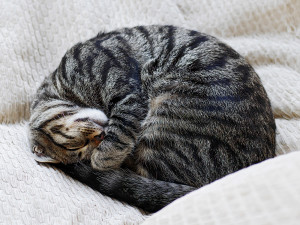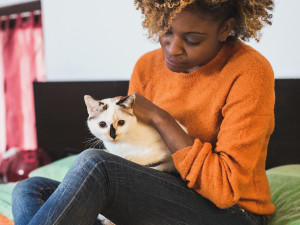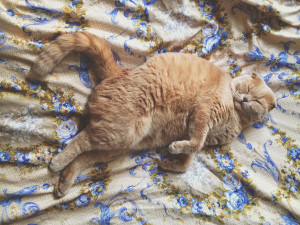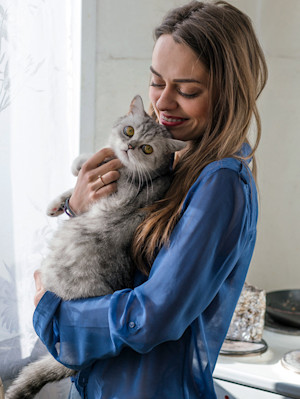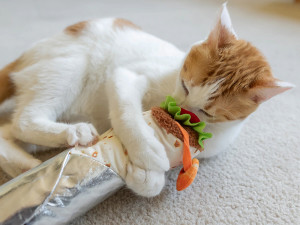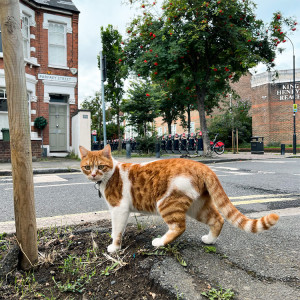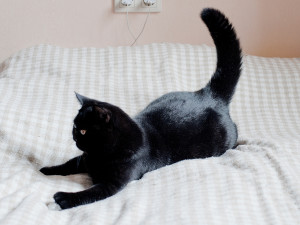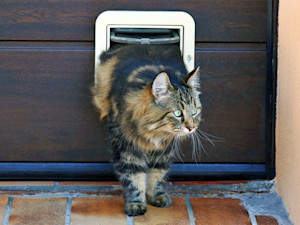Does Your Cat Need a Gym?
We delve into all things feline fitness to learn whether your cat should be shredding and shedding
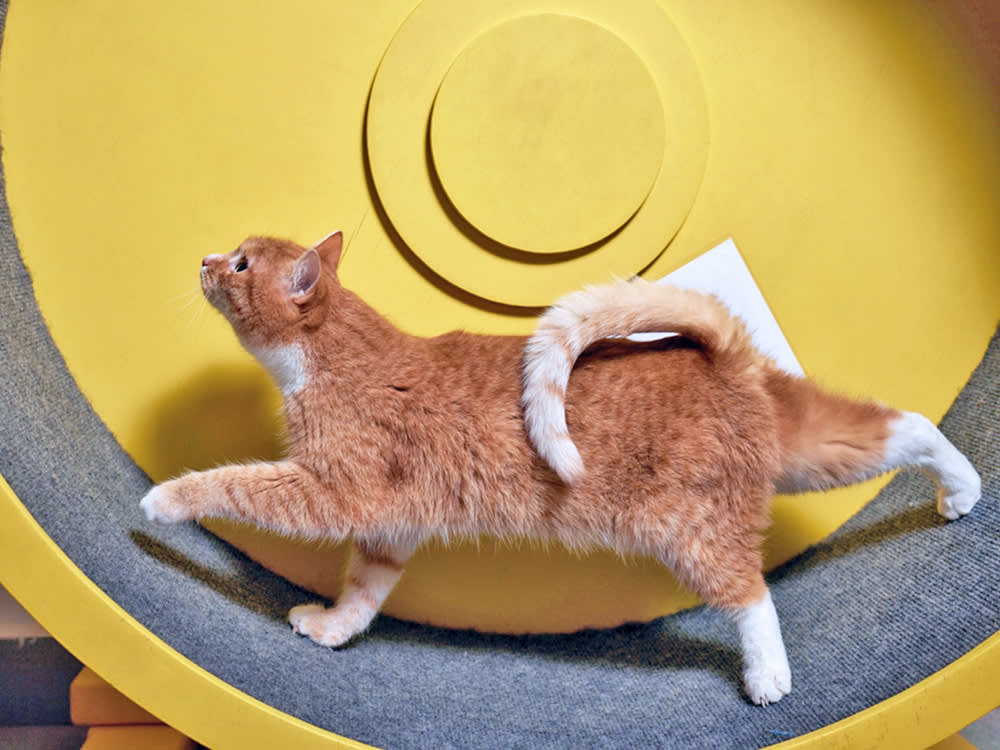
share article
If, like us, your TikTok For You Page is a non-stop carnival of cats doing things you never thought you’d see, you might have come across the recent trend of cats trotting on treadmills or running on what looks like a giant hamster wheel. Online pet parents are increasingly showcasing the home gyms they’ve created for their cats, which feature everything from exercise wheels to trampolines, treadmills and climbing posts. And while it’s fun to imagine our feline companions morphing into a rock-climbing, gym bro stereotype, do cats actually need a gym or is this just a social media trend? If so, how safe is all this equipment for them to use? We spoke to the experts to find out.
Does my cat need exercise?
As cat parents, we know that our cats sleep a lotopens in a new tab – between 12 and 18 hours per dayopens in a new tab, in fact, with senior catsopens in a new tab and kittensopens in a new tab needing the most sleep. But even these lazy fluff balls need exercise to stay healthy, too. “Cats need about 30 minutes of moderate exercise per day,” says trainee veterinary nurse Becky Wakefield. And with 53 percent of catsopens in a new tab in the UK classed as overweight or obese, getting enough exercise is particularly important for the chonkier cats out there. “Obesity in catsopens in a new tab can lead to health issues including osteoarthritis, heart disease and diabetes,” explains Becky. But how do you know if your cat falls into that category? (Disclaimer: we’re not fat shaming – we just want all cats to be healthy and happy!)
“Sometimes, pet parents have difficulty recognising that their cats are overweight,” says Dr Bruce Kornreich, director of the Cornell Feline Health Center. Although the average cat weighs around 4.5kg, a Maine Coon is significantly heavier than a Siamese cat. This is why veterinarians don’t use a scale, but rather, rely on a visual assessment or Body Condition Scoring Systemopens in a new tab (BCS), which ranks from one to five – three being considered the ideal weight. As such, your cat would have an hourglass figure with a visible waist and an abdominal ‘tuck’ where their belly meets their hips. While cats with visible vertebrae are considered underweight, cats with an ‘obvious rounding of the abdomen’ (rude!) may need to start counting their macros.
Although only 30 percent of cats live an indoor-only life in the UK, these indoor cats with 24/7 access to food-filled bowls are the most likely category (sorry) to be overweight. “While cats who do venture outsideopens in a new tab might not be running laps around the neighbourhood and are more likely to go for some light leisurely strolls, this level of activity can still be ample for the average cat,” explains Becky. So if your outdoor cat does score high on the BCS, it could be related to their food and treat intake as opposed to their lack of exercise. If this is the case, “First and foremost, reduce your cat’s calorie intake,” says Becky. This means closing the all-you-can-eat buffet, starting a proper feeding schedule, portioning out meals and cutting back on treats. Your vet can create a tailored weight reduction plan or write a prescription for a low-calorie diet, if needed.
Kitty cardio
If your cat is already slim, active, goes outside to roam and plays a lot, you may not need to encourage them to do additional exercise. However, if they are a bit more sedentary, don’t have access to the outdoors, or score high on the BSC, you might want to consider introducing exercise to their daily routine.
“Cats are cursed with a particularly slow metabolism,” explains Becky, so just cutting down your overweight cat’s calories won’t lead to instant weight loss. “Increasing your cat’s activity levels will help speed up the metabolic rate,” says Becky. Cats are naturally active in short bursts (something we love about them when they’re zooming roundopens in a new tab the house at 4am), and studiesopens in a new tab have shown that a simple 10-minute play session per day can be as effective as diet restriction for weight loss. “This can look like encouraging your cat to run around the room after a wand toyopens in a new tab, or chase a laser pointeropens in a new tab or ball to get them moving,” says Becky.
“A good place to start is one 10-minute session per day,” says Becky, which you can increase to two sessions per day or longer sessions as your cat gets fitter and more enthusiastic. “Keep play sessions short so your cat is still enjoying it, and stop the session if and when they seem to lose interest,” says Becky. Some cats who have lived a predominantly lazy life might take a bit more encouragement to play and engage with games, but don’t give up. If one type of play doesn’t interest them after a few attempts, use your imagination to try and entice them with something else. Cats are natural huntersopens in a new tab and it’s hardwired in them to chase and pounce, so you will be able to trigger that instinct in them with some persistence – a bit like activating a sleeper agent, you just need to find the right combination of words/toys.
“While it may seem counterintuitive, for food-obsessed cats, you can also design feeding strategies that mean your cat has to climb or search for their food,” suggests Becky. “Puzzle feedersopens in a new tab can also be used to increase the amount of calories burned.” Every little helps, right?
What’s in a cat gym?
“Encouraging your cat to be active is never a bad thing,” says Becky. But there are some safety considerations to take into account if you plan to turn your home into a PurrGym. So let’s break down the pros and cons of feline fitness equipment.
Exercise wheels
Cat exercise wheels, or cat wheels as they’re sometimes called, are basically scaled-up hamster wheels that a cat can walk or ‘jog’ on. “Cat wheels can provide a really good outlet for felines to burn off excess energy and calories, and keep them physically and mentally active,” says Becky. But like anything you buy for your cat, whether they’ll actually use it or not is a different story. “If you buy your cat a £10 toy and they aren’t interested in playing with it, it’s no big loss, but cat exercise wheels can cost in the region of £150opens in a new tab, so if your cat doesn’t take to it, that’s going to be quite frustrating financially for cat parents.”
If you do decide to take the leap, firstly, it’s important to ensure you invest in the right size cat wheel. Pet store Lapa Pets explains on their siteopens in a new tab: “There is a rule of thumb that the diameter of the wheel should be at least 2–2.5 times the length of the cat’s body on all four paws. So, if your cat is 50cm long, the diameter of the wheel should be between 100 and 125cm. The larger the wheel, the more comfortable it will be for your cat to run in it.” A wheel that is too small for your cat can lead to spinal injuries, explains Becky.
Next, it’s important to ensure you build the cat wheel correctly; this isn’t like cobbling together flat-pack furniture and living with a slightly wonky drawer – your cat’s safety is at stake so it’s vital to make sure you put it together correctly. A badly assembled cat wheel might have misaligned wheels or loose screws that can stop the rotation of the wheel suddenly, cause the wheel to spin out of control so that your cat might lose their footing, or even cause it to come apart while your cat is using it. “You should also make sure you place the cat wheel somewhere safe in your house, away from things that could fall on to the wheel/your cat if they get knocked or jostled by the movement,” cautions Becky.
Supervising your cat at all times while they’re using the wheel is also very important. “A safe and proper cat wheel will come with a safety lock,” explains Becky, which you should use when you leave the house or leave the room that the cat wheel is in.
When it comes to training your cat to use the wheel, make sure to keep sessions short and don’t let your cat get too tired. Certain breeds such as Bengals, Savannahs and Maine Coons may take to a cat wheel more naturally due to their active and curious natures. Becky advises holding a high-value treat just out of reach in front of their nose to encourage them to start walking, and they’ll soon get the hang of how it works – think carrot and stick. “Keep training sessions to a maximum of 10–20 minutes each day, especially if your cat is just starting out or is unfit,” says Becky.
Treadmills
Some cat parents have also put mini treadmills in their cat gyms. However, Becky explains that these are not made for animals to use, and while it might seem cute to watch your cat run on a treadmill, it’s very unsafe. “Putting your cat on a treadmill designed for humans comes with a huge risk of stress or injury,” says Becky. Unlike the cat wheels, the average treadmill runs on electricity and therefore won’t stop if the cat loses their footing or can’t keep pace, which can lead to your cat falling off or getting dragged under the machine. TL;DR – don’t put your cat on a treadmill.
Trampolines
When we say trampolines in this context, we don’t mean that you should place your cat on a big outdoor trampoline with you where they can go flying off into the air at first bounce. We mean those little mini Pilates/workout trampolines that are very low to the ground. “Some cats might enjoy the experienceopens in a new tab of exploring a trampoline but I wouldn’t expect them to do much up-and-down bouncing, as it’s not conducive to their centre of gravity or the fact they have four legs,” explains Becky. So a trampoline is less of a high-intensity piece of exercise equipment as it is something new and exciting for your cat to play on. “If your cat is the curious type, they might like the opportunity to climb and play on a little trampoline. You can throw toys or treats on the trampoline to encourage your cat to climb up.”
As with the cat wheel, it’s still important to supervise your cat while they’re near or on the trampoline, as their paws can get caught in the edges or they might tip it over on to themselves causing injury.
Trees, shelves and climbing equipment
Cats love to climb and claw, and most cats should have access to a scratching postopens in a new tab for this reason. But there are a few ways you can encourage your cat to get moving a bit more using cat treesopens in a new tab, wall-mounted platforms and climbing posts.
“Providing your cat with a range of towers, posts and platforms can be a simple and effective way of encouraging them to move around your home,” says Becky. If you have the space, screw some platforms to the wall a few inches apart so your cat has to jump a little bit to get from each one. Or get your hands on a cat tower that they can climb up. “The best thing about this method of exercise is that you can lead your cat around the ‘course’ that you’ve set up using a toy or treats – and all these items are easy to find secondhand if you’re on a budget,” says Becky.
So what’s the verdict? Does your cat need a gym? Not really. You can provide ample exercise for your cat using simple, inexpensive toys – as long as they’re moving, you’re doing it right! And if you do decide to invest in an exercise wheel or any other piece of equipment, make sure your cat’s safety is at the forefront of your mind at all times and never leave them unsupervised.
Ro Elfberg
Ro is The Wildest UK’s Senior Editor. She has previously written and copy-edited for British Vogue, Glamour and DICE. When she’s not being manipulated into dishing out Dreamies to Kobe the cat, she spends her free time trying to convince her snake, Butters, to wear a tiny hat.
Related articles
![A ginger and white cat standing on a London street.]() opens in a new tab
opens in a new tabIs It Safe to Have an Outdoor Cat in the UK?
Free-roaming felines are much more common here than in other parts of the world – we uncover the reasons why
![black cat doing zoomies on a bed]() opens in a new tab
opens in a new tabYour Cat’s Erratic Zoomies – Explained
Fast, furious and officially normal – according to a cat behaviourist
![Cat laying inside a cat tree]() opens in a new tab
opens in a new tabCat Trees That Won’t Clash With Your Aesthetic
Stylish cat trees for every home and personality, from cartoon flowers to modernist towers
![A tabby cat exiting a cat flap]() opens in a new tab
opens in a new tabMicrochip Cat Flaps: Unlocking the Secrets
Give your cat a key to the outside world
![overweight orange cat]() opens in a new tab
opens in a new tabHow Much Should You Actually Be Feeding Your Cat?
If they’ve lost their hourglass figure, then not that much – according to a veterinary nutritionist
